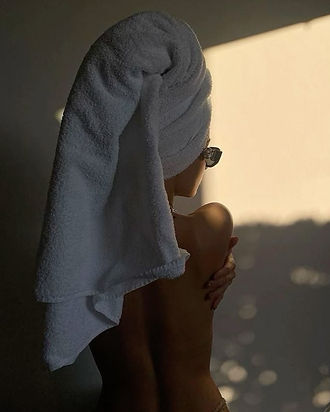


WAXING 101:
What to know before your first appointment
.jpeg)
Welcome to Your First Wax!
Getting your first wax or sugaring service can feel a little intimidating, but we’re here to make it easy and comfortable from start to finish. Our studio is a safe, inclusive space where every body is welcome — no matter your gender, shape, or experience level. We'll walk you through the process step by step, check in along the way, and make sure you always feel cared for, respected, and never rushed.
Sugaring and waxing are both effective ways to remove hair from the root — but they work a little differently. Waxing uses a resin-based formula that adheres to both hair and skin, while sugaring uses a natural paste made from sugar, lemon, and water that only sticks to hair and dead skin. This makes sugaring gentler, less irritating, and a great option for sensitive areas.
Below, we’ve broken down the big three methods of hair removal — sugaring, soft wax, and hard wax — so you can understand the difference and choose what’s right for you.
Sugaring vs. Waxing
What's the difference?
THE BIG THREE
Sugaring, Soft Wax & Hard Wax

SUGARING
Sugaring is a natural form of hair removal made from just three ingredients — sugar, lemon, and water. The paste is applied against the direction of hair growth and removed with it, gently pulling hair from the root while minimizing irritation, breakage, and ingrown hairs. Because it only adheres to hair and dead skin, it’s safe for sensitive areas and helps leave the skin smooth and soft.

SOFT STRIP WAX
Soft wax is a quick and effective method used for smaller or more precise areas such as the brows, upper lip, and chin. It’s applied in a thin layer and removed with a fabric strip, taking both hair and dead skin cells with it for a smooth finish. The soft wax used here is gentle, soothing, and ideal for clients with normal to sensitive skin.

HARD WAX
Hard wax is applied thickly, allowed to harden on the skin, and then removed without a strip. It’s commonly used in many studios for sensitive areas but can be more aggressive on the skin due to the way it adheres. While effective for quick hair removal, it can sometimes cause irritation or discomfort for certain skin types.
Why We Don't Use Hard Wax
While hard wax can be effective for quick hair removal, it isn’t the gentlest option for your skin. Because it adheres more strongly to the surface, it can sometimes cause irritation, redness, or sensitivity — especially in delicate areas.
We choose to focus on sugaring and soft wax instead, since both provide smooth, lasting results without compromising skin health. These methods are kinder, cleaner, and more consistent, allowing us to give you the same great results with less irritation and more comfort every time.


What to Expect During Your First Wax

If this is your first Brazilian or body wax, don’t be nervous — we’ll walk you through it step by step. Here’s what you can expect
1
First Time Follicles
Because your hair hasn’t been removed from the root before, it may take 2–3 wax cycles to reach peak smoothness.
2
Appointment Length
Depending on the area, sessions typically take 20–45 minutes.
3
During Your Cycle
Yes, you can wax on your period! Just know that your skin may feel a little more sensitive. We ask that you wear a fresh tampon or cup, and we’ll take care of the rest.
4
Hair Length
Aim for ¼ inch of growth (about a grain of rice). That’s usually 3 - 4 weeks after waxing or 10 - 14 days after shaving.
5
Trimming
No need! Leave it as is — trimming too short can make removal less effective.

Why Choose Waxing or Sugaring Over Shaving?
+ Longer-lasting results — smooth for weeks, not days.
+ No razor bumps, cuts, or daily upkeep.
+ Regrowth becomes finer and softer with consistency.
+ Sugaring especially helps reduce ingrowns and irritation.
Alcohol & Caffeine
1
These stimulants can make your skin more sensitive and increase discomfort.
Retinol, AHAs, BHAs & Exfoliants
2
Stop using these at least 3 days before and after waxing — they thin the skin and can cause irritation.
Accutane or Similar Medications
3
Do not wax if you’re currently on Accutane (or have been in the last 6 months). Other skin medications like Retin-A can also make the skin too fragile for waxing.
Heavy Lotions, Oils, and Deodorant
4
Skip these on the day of your appointment, as they can block the wax or sugar from gripping the hair.
Tanning (Including Spray Tans)
5
Avoid self-tanner or UV tanning in the 48 hours before your appointment, as it can make the skin more prone to irritation.
Shaving Right Before:
6
Shaving disrupts the hair growth cycle. Wait at least 10–14 days after shaving before sugaring or waxing for best results.

What to Avoid Before Your Wax
.jpeg)
To keep your skin safe and make the process more comfortable, here are a few things to skip in the days leading up to your appointment

If you’re waxing before a wedding, vacation, or big event, the sweet spot is 2–3 days beforehand. First-timers should try a full cycle before their event so their skin has time to adjust.
Timing for
Special Events
PREP & AFTERCARE
To get the most out of your appointment
.png)
BEFORE

AFTER
Exfoliate the day before (not right before), skip lotions, and ensure hair is long enough.
Wear loose clothing, avoid heat and sweat for 24 hours, and keep the area clean and hydrated.